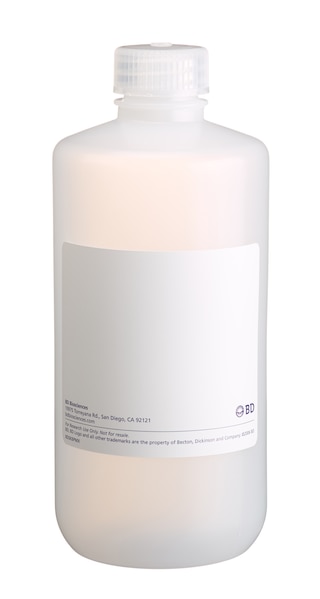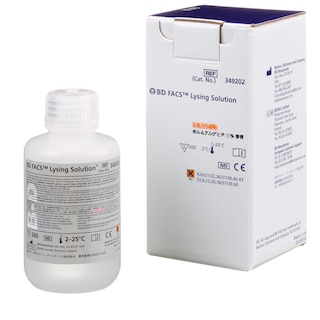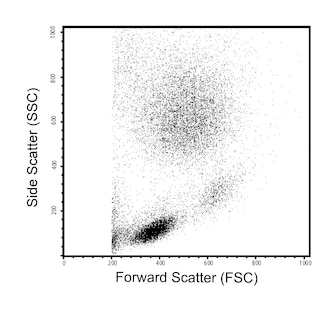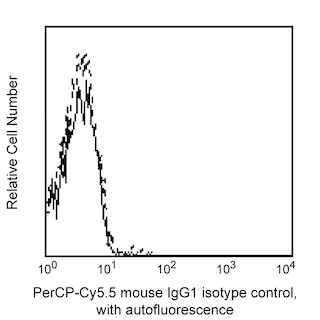Old Browser
This page has been recently translated and is available in French now.
Looks like you're visiting us from {countryName}.
Would you like to stay on the current country site or be switched to your country?




Flow cytometric analysis of CD27 expression on human peripheral blood lymphocytes. Whole blood was stained with either PerCP-Cy™5.5 Mouse IgG1, κ Isotype Control (Cat. No. 550795; dashed line histogram) or PerCP-Cy™5.5 Mouse Anti-Human CD27 (Cat. No. 560612; solid line histogram). Erythrocytes were lysed with BD PharmLyse™ Lysing Buffer (Cat. No. 555899). Fluorescence histograms depicting CD27 (or Ig isotype) expression were derived from gated events with the side and forward light-scattering characteristics of viable lymphocytes. Flow cytometry was performed on a BD™ LSR II system.


BD Pharmingen™ PerCP-Cy™5.5 Mouse Anti-Human CD27

Regulatory Status Legend
Any use of products other than the permitted use without the express written authorization of Becton, Dickinson and Company is strictly prohibited.
Preparation And Storage
Product Notices
- This reagent has been pre-diluted for use at the recommended Volume per Test. We typically use 1 × 10^6 cells in a 100-µl experimental sample (a test).
- An isotype control should be used at the same concentration as the antibody of interest.
- Source of all serum proteins is from USDA inspected abattoirs located in the United States.
- Caution: Sodium azide yields highly toxic hydrazoic acid under acidic conditions. Dilute azide compounds in running water before discarding to avoid accumulation of potentially explosive deposits in plumbing.
- Please observe the following precautions: Absorption of visible light can significantly alter the energy transfer occurring in any tandem fluorochrome conjugate; therefore, we recommend that special precautions be taken (such as wrapping vials, tubes, or racks in aluminum foil) to prevent exposure of conjugated reagents, including cells stained with those reagents, to room illumination.
- PerCP-Cy5.5 is optimized for use with a single argon ion laser emitting 488-nm light. Because of the broad absorption spectrum of the tandem fluorochrome, extra care must be taken when using dual-laser cytometers, which may directly excite both PerCP and Cy5.5™. We recommend the use of cross-beam compensation during data acquisition or software compensation during data analysis.
- PerCP-Cy5.5–labelled antibodies can be used with FITC- and R-PE–labelled reagents in single-laser flow cytometers with no significant spectral overlap of PerCP-Cy5.5, FITC, and R-PE fluorescence.
- For fluorochrome spectra and suitable instrument settings, please refer to our Multicolor Flow Cytometry web page at www.bdbiosciences.com/colors.
- Species cross-reactivity detected in product development may not have been confirmed on every format and/or application.
- Cy is a trademark of GE Healthcare.
- Please refer to www.bdbiosciences.com/us/s/resources for technical protocols.
Companion Products





The M-T271 monoclonal antibody specifically binds to CD27. CD27 presents as a type I transmembrane, disulphide-linked 110 kDa homodimer comprised of two polypeptide chains. The CD27 molecule is a lymphocyte-specific member of the TNF/NGF-R family, and is expressed on a subset of human thymocytes and on the majority of mature T lymphocytes, activated B cells and NK cells. CD27 is highly induced on T cells after TCR stimulation. CD27 binds to CD70 (also known as, CD27 ligand or CD27L) and may be involved in cellular interaction of T and B lymphocytes.

Development References (3)
-
Bigler RD, Bushkin Y, Chiorazzi N. S152 (CD27). A modulating disulfide-linked T cell activation antigen. J Immunol. 1988; 141(1):21-28. (Biology). View Reference
-
Bigler RD, Donat TL, Boselli CM. Definition of three epitopes of the CD27 molecule [P 120->55] present on activated normal lymphocytes. In: Knapp W. W. Knapp .. et al., ed. Leucocyte typing IV : white cell differentiation antigens. Oxford New York: Oxford University Press; 1989:351-352.
-
Schlossman SF. Stuart F. Schlossman .. et al., ed. Leucocyte typing V : white cell differentiation antigens : proceedings of the fifth international workshop and conference held in Boston, USA, 3-7 November, 1993. Oxford: Oxford University Press; 1995.
Please refer to Support Documents for Quality Certificates
Global - Refer to manufacturer's instructions for use and related User Manuals and Technical data sheets before using this products as described
Comparisons, where applicable, are made against older BD Technology, manual methods or are general performance claims. Comparisons are not made against non-BD technologies, unless otherwise noted.
For Research Use Only. Not for use in diagnostic or therapeutic procedures.
Report a Site Issue
This form is intended to help us improve our website experience. For other support, please visit our Contact Us page.